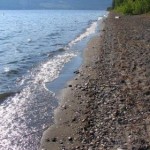Don’t let this week’s storm clouds and the few drops of rain that fell lull you into thinking this summer’s dry conditions are all wet now.
Much of the small amount of rain that fell evaporated when it hit the hot ground, or was immediately sucked up by parched soil. Not much ran off into streams or lakes.
So the groundwater table was not replenished.
June is normally the wettest month of the year in the Okanagan, but this year it was near the record for a lack of rainfall.
That wouldn’t be a big deal except it followed six months of near-record dry conditions here, with inflow to Okanagan Lake the six lowest since records were first kept in 1921.
That would not be such a so bad thing had Okanagan Lake filled in June as it normally does. In fact, I remember a few years ago watching as residents filled sand bags to keep the rising water from melting snow at bay, before it could inundate their homes.
We’re a far cry from that this year. In fact, the big lake that runs down the centre of the valley is a half-metre below being full this year, much less overflowing, and releases from the dam at the south end have been kept to an absolute minimum all year.
We’re on a totally controlled water system in this basin, but having control unfortunately doesn’t mean we can fill that system with water when we wish, especially if the natural rainfall or snow doesn’t show up.
This is an extremely water-short valley, with Canada’s only desert located in the southern part of it. We are totally dependent on the snow that collects each winter in the hills around the valley, for the water we need to grow crops and wash our faces the rest of the year.
It’s stored in upland reservoirs in spring and as the snow melts, it isgradually released during the remaining months when heat at lower elevations dries out the ground and threatens to dry up streams as well.
Several of those reservoirs didn’t fill this spring either. In fact, McCulloch Lake, the storage reservoir for water users in the southeast part of Kelowna, was only 67 per cent full at the time of year when it’s normally full and spilling water over its dam and down into the valley below.
And users were already busy watering crops and lawns, taking water early from storage to do so.
The scenario is similar on the west side of Okanagan Lake, with the Westbank Irrigation District already moving to stage-two of its sprinkling restrictions, limiting water use on lawns and gardens to two days a week.
That doesn’t necessarily mean we’ll see brown lawns in those areas, but we do need to be more flexible about our expectation for landscapes around our homes. In a near-desert climate, green lawns are an inappropriate luxury – one we can’t afford.
If growing green things is your thing, concentrate on your vegetable garden instead of a swath of turf.
At least it’s practical, and it would require less water than the conventional turf grasses, as well as less fertilizer. (There are, incidentally, turf grasses which do not require large amounts of water to survive in this climate, and which are still soft and green and lush-looking.
They require less mowing as well. Go to: www.bluestem.ca and click on Enviro-Turf Lawn on the top bar. I bought this last year and planted it in the fall. It’s beautiful this summer, despite the best efforts of the deer to pound it down into China.
Residues from fertilizers pollute that water that we don’t have enough of, making it unfit to drink, or for habitat.
And, habitat is another issue that will surface this year as a result of low water conditions.
Not only will frogs and salamanders, ducks and geese suffer from streams, ponds and wetlands drying up, so will fish and other aquatic creatures.
For instance, it had been hoped that last fall’s surge in returns of sockeye salmon up the Columbia River system into the Okanagan could result in a good output of young salmon to return to the ocean.
However, they spend their first year in Osoyoos Lake, which is shallow and tends to warm up too much in summer to provide ideal conditions.
The resulting temperature/oxygen squeeze could be relieved by release of pulses of water from Okanagan Lake in late August and early September.
However, unless we’re all extremely cautious in our use of water this summer, there might not be enough to provide the extra water needed to keep those smolts alive and well for the long trip back to the ocean.
Even more important, last year’s 50-year record return of sockeye to this valley might be an isolated incident if there isn’t enough water to accommodate this fall’s returning salmon in the Okanagan system.
Surely, when such catastrophic events as drought and survival of a species are at risk, we can find it within our abilities to use a little less water—or at the very least, to waste a little less water.

